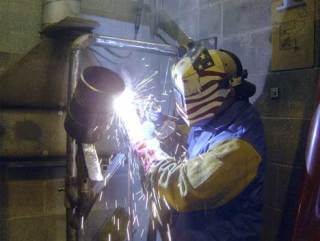When Enrique Rosano got out of the Army in 2006, he had hopes of transitioning back to civilian life with a high-paying job.
“I knew I wanted out and I wanted a great job, but it didn’t happen,” Rosano, 26, said. “Sometimes I worked, sometimes I didn’t.”
After serving his country, including a 2003-2004 stint in what he calls the “Sandpit” of Iraq, Rosano went through the transition to get out of the military, but left his post on the airborne infantry with a lack of marketable skills.
“I could wake up pretty early in the morning, was in good shape,” he said, adding that he also knew which uniform to wear at what time. “Nothing more than that.”
After working construction for a few years, the purple Heart and Army Achievement Medal recipient was tired of the job’s inconsistencies, especially in pay.
“When he got paid, I got paid,” Rosano said, of the contractor for whom he worked.
Rosano, who presently lives in Federal Way, was ready to head home to Arizona when a buddy of his heard about Veterans In Piping, a new program designed to re-train veterans as skilled laborers in the pipefitting trade.
“It sounded like a lot more going on than what I had,” Rosano said.
Developed by the United Association of Plumbers, Pipefitters and Sprinklerfitters, Veterans In Piping, or VIP, is an 18-week program that features an accelerated welding component to train vets to help fill positions that are being left vacant by retiring Baby Boomers.
“There’s a shortage of skilled workers,” said Ed Holmes, training coordinator for the Seattle Area Pipe Trades and a veteran himself. “And we know for a fact that servicemen make good journeymen.”
Holmes, who teaches at the Seattle Pipe Trades Education Center in Renton, said the program is designed to “tap an untapped resource,” but is also “the right thing to do.”
“Contractors are Americans too,” he said. “They know it’s the right thing to do to help the vets.”
According to a press release from the UA, unemployment among veterans is three times that of non-vets in the same age group.
And according to Holmes, there are many similarities between being in the military and working on a job site, including precision, teamwork, attention to detail and safety issues, though he admits the work is not nearly as dangerous as where many of the vets served their last job.
“You don’t have people firing bullets at you, but it’s still dangerous,” he said.
Holmes said there are five main reasons why military folk do well in his trade: They show up, they are on time, they have a positive attitude, they are drug free and they know how to work.
He also said veterans are better disciplined than others looking to learn the trade.
“That’s probably the biggest key out of the whole deal,” he said.
Rosano said the 18-week program involved some transition talk (such as teaching the newly returned vets not to speak in military lingo) for two weeks and then 16 intensive weeks of training followed by a welding test, which he passed.
“They got me a job and I went to work,” he said.
So far, Rosano sees some similarities in the work, like the tight-knit group and the emphasis on safety (“They make sure you come home with 10 toes and 10 fingers, just like the Army.”) but also a few key differences.
“The difference is that you get paid per hour and you’re not working 15 hours a day,” he said.
Holmes said welders who go on to be journeymen after their five-year apprenticeship could make $60 an hour in salaries and benefits. In the meantime, apprentices are paid for their time as well.
“You earn while you learn,” Holmes said. “What apprenticeship does is opens the door of opportunity.”
According to the press release, the UA has made an annual commitment of more than $140 million with the goal of training 50,000 apprentices this year. UA Local No. 26 in Lacey was the first to implement the program, followed by Local No. 32 in Seattle. The program is set to go national next year.
Holmes said there is no cost to the vets, with the fees being paid by the UA, the Veteran’s Administration and unemployment.
According to Washington State Department of Veterans Affairs Director John Lee, the program helps remove a barrier between recently-returned veterans and family-wage jobs.
“Ensuring that all veterans separating from the military have a smooth transition into their civilian lives is a mission I take very seriously. In my mind, there is no better way to make that transition smooth than by helping the individual find a good job, one with plenty of possibilities for advancement,” Lee said in a press release. “That’s where UA and the Veterans In Piping Training Program comes in.”
After beginning his new career as a welder, Rosano said he is very pleased with the program and would recommend it to anyone coming out of the military.
“Getting out is a scary thing and if you are young and the economy is bad and you don’t know anything, this can help a lot.” he said. “If they could have told me something like this, I’d have been all for it.”
For more information or to sign up, visit www.uavip.com.
Talk to us
Please share your story tips by emailing editor@kentreporter.com.
To share your opinion for publication, submit a letter through our website https://www.kentreporter.com/submit-letter/. Include your name, address and daytime phone number. (We’ll only publish your name and hometown.) Please keep letters to 300 words or less.

